The story of the race for the Democratic presidential nomination continues to be Joe Biden’s resiliency and strength nationally and in the larger, more diverse states that choose convention delegates after Iowa and New Hampshire. Your reaction to the photo above is likely a pretty good test of whether this cheers, reassures, frustrates, or infuriates you.
Biden’s rivals, along with many pundits and Dem operatives, activists, and big donors, have been waiting for his supposedly inevitable implosion since before he even formally announced he was running.
But as the final countdown to 2020 begins, it’s looking more and more like Biden isn’t a paper tiger in the mold of Jeb “Please Clap” Bush in 2016 — an early front-runner based on near-universal name recognition — but an energizer bunny à la Mitt Romney in 2012 — favored by at least a plurality of primary voters as acceptable and electable.
Or using another dated reference Biden would appreciate, he’s like a Timex watch: he takes a licking, but keeps on ticking.
In what’s often cited as Peak Clueless Coastal Liberal Insularity, the great film critic Pauline Kael is frequently misquoted as having said after the 1972 election, “I can’t believe Nixon won. I don’t know anyone who voted for him.”
But like pretty much everything Kael ever said or wrote, her coastal liberal insularity was nothing if not knowing. Here’s what she actually said: “I live in a rather special world. I only know one person who voted for Nixon. Where they are I don’t know. They’re outside my ken. But sometimes when I’m in a theater I can feel them.”
Hopefully no one who reads this will be blindsided if Biden goes on to win the nomination.
Which if he does will be in no small part because of his appeal to Democrats across the country who find something both calming and reassuring in the goofy mid-century, middle-American sensibility of a candidate who’d go on a “No Malarkey!” bus tour.
(And for what it’s worth, it’s a callback to this moment when Biden filleted Paul Ryan in the 2012 vice presidential debate.)
Looking at the latest numbers, here are Nate Silver’s averages nationally and in the early states and key Super Tuesday contests:
NATIONAL: Biden 26, Warren 19.7, Sanders 16.7, Buttigieg 7.5
IOWA: Buttigieg 21.6, Sanders 18.4, Biden 17.5, Warren 15.9
NEW HAMPSHIRE: Biden 20.0, Warren 18.0, Sanders 17.0, Buttigieg 15.0
NEVADA: Biden 27.6, Sanders 19.3, Warren 18.6, Buttigieg 7.3
SOUTH CAROLINA: Biden 37.6, Sanders 12.8, Warren 11.9, Buttigieg 5.5
CALIFORNIA: Biden 23.0, Warren 20.6, Sanders 19.2, Buttigieg 7.6
TEXAS: Biden 25.3, Warren 15.3, Sanders 14.1, Buttigieg 6.1
NORTH CAROLINA: Biden 33.8, Warren 15.1, Sanders 14.6, Buttigieg 6.0
VIRGINIA: Biden 30.9, Warren 15.0, Sanders 14.5, Buttigieg 8.3
Elizabeth Warren may well have survived her initial embrace of Bernie Sanders’ and AOC’s maximalist version of Medicare-for-All, and it’s call for the abolition of private health insurance. But she may have dealt her candidacy a self-inflicted fatal blow when — trapped by her persona as “the plans” candidate? — she offered a detailed road map to her goal of “robust” Medicare-for-All.
Her plan has led to problems among Democratic moderates and union-members (because it calls for the abolition of private insurance) and on the left (because she says she won’t try to pass full-on M4A until her administration’s third year — by which time it would likely be out of reach if, as is typical, Dems suffer big midterm losses in Congress).
Meanwhile, Pete Buttigieg’s rise in Iowa, and to a lesser extent in New Hampshire, has been fueled by highly-educated white Democrats. That’s Warren’s base, not Biden’s, and Buttigieg’s growing support appears to have come at Warren’s expense despite their ideological differences. Still, there’s no sign of either breaking though among the more diverse electorates of South Carolina, Nevada, and the Super Tuesday states.
And the general election? THE NEW YORK TIMES had a big story this week with an ominous headline for Democrats: “They Voted Democratic. Now They Support Trump. Two-thirds of battleground state voters who chose Trump in 2016 but selected Democrats in the midterms say they will return to the president next year.”
These voters represent 2% of registered voters in these states, and are overwhelmingly white, male, and without college degrees. It’s Trump who should be alarmed if he’s shed one-third of this slice of the electorate. They represent more than his narrow margins of victory in Pennsylvania, Michigan, and Wisconsin.
Moving on to impeachment, Adam Schiff’s House Intelligence Committee will approve this week a report to send to the House Judiciary Committee, which will then consider and vote on articles of impeachment for the full House to vote on.
A CNN poll last week got a lot of attention for showing support for Trump’s impeachment and removal from office was unchanged from October despite two weeks of objectively devastating public hearings. This followed a few polls that seemed to show support for impeachment and removal dipping.
But as this graph of polling averages shows, overall support for impeachment is ticking up again after briefly dipping before the hearings. The hearings didn’t change minds, but did solidify support at October levels, after most people paying attention had absorbed the basics of the Ukraine story.
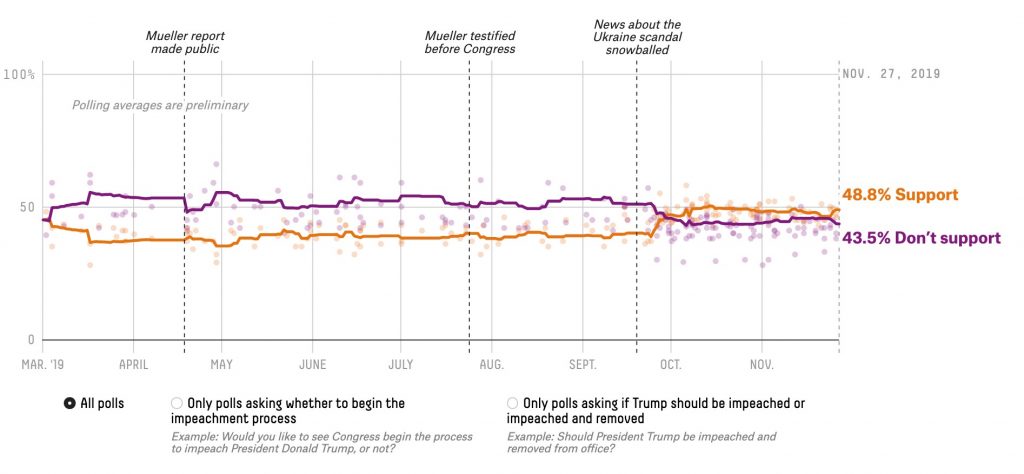
The evidence of Trump impeachable offenses is overwhelming. Yet the media continues to act as if the strength of the case against him should be measured by whether it changes the minds of congressional Republicans or the GOP base — as if either are considering the evidence in good faith.
As Greg Sargent writes in THE WASHINGTON POST, “If there is one widely shared conclusion about the impeachment hearings that have just concluded, it’s that President Trump’s GOP defenders were never ‘gettable’… Some defenders have flatly inverted what was actually testified to into its diametrical opposite. Others have reflexively reverted to conspiracy theories creating a universe as divorced from the actual corrupt conduct now being examined as one former half of a divided cell is from the other.”
Since we should only expect the same from Senate Republicans, Sargent writes, we should begin to “treat Trump’s defenders as his criminal accomplices. Not just as ‘enablers’ of [his] corruption but as active participants in it. Once this is accepted, it becomes obvious why they can’t be ‘won over,’ because they are actively engaged in keeping the corruption in question from getting fully uncovered, in the belief that they, too, benefit from it, and that they, too, lose out if it’s exposed.”

For an excellent narrative of what we now know about Trump’s single-minded efforts to extort Ukraine into manufacturing dirt on Joe Biden and exonerating Russia for it’s sabotage of the 2016 election, check out this recap in LAWFARE.
And if you have any lingering doubts about Russia’s complicity, check out this 60 MINUTES segment from last week detailing exactly how Russian military intelligence officers broke into the Democratic Party’s computers, stole compromising information, and selectively released it to undermine candidates up and down the ballot.
¤
THE ATLANTIC “What Joe Biden Can’t Bring Himself to Say. His verbal stumbles have voters worried about his mental fitness. Maybe they’d be more understanding if they knew he’s still fighting a stutter.” Whatever your views on Biden, this is a beautiful article about Biden’s and author John Hendrickson’s lifelong struggles with stuttering.
¤
THE NEW YORK TIMES “Jeffrey Epstein, Blackmail and a Lucrative ‘Hot List’. A shadowy hacker claimed to have the financier’s sex tapes. Two top lawyers wondered: What would the men in those videos pay to keep them secret?” This must-read article reads like a pulpy thriller, and offers a fascinating look at the lengths top lawyers and journalists will — and won’t — go to get a story.
¤
PEW RESEARCH CENTER “In US, Decline of Christianity Continues at Rapid Pace. An update on America’s changing religious landscape.”The religious landscape of the United States continues to change at a rapid clip. Pew found that 65% of American adults describe themselves as Christians, down 12 percentage points over the past decade. Meanwhile, the share of the population who describe themselves as atheist, agnostic or “nothing in particular,” now stands at 26%, up from 17% in 2009.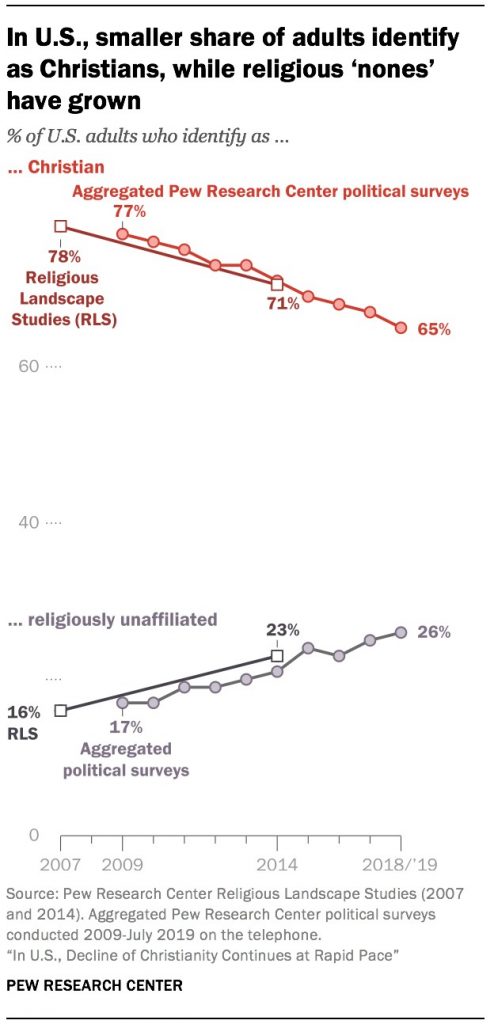
Rates of religious attendance are also declining. The share of Americans who say they attend religious services at least once or twice a month dropped by 7 percentage points over the past decade. Those who say they attend religious services less often (if at all) has risen by the same amount. The data shows a wide gap between Baby Boomers and members of the Silent Generation on the one hand, and Millennials on the other:
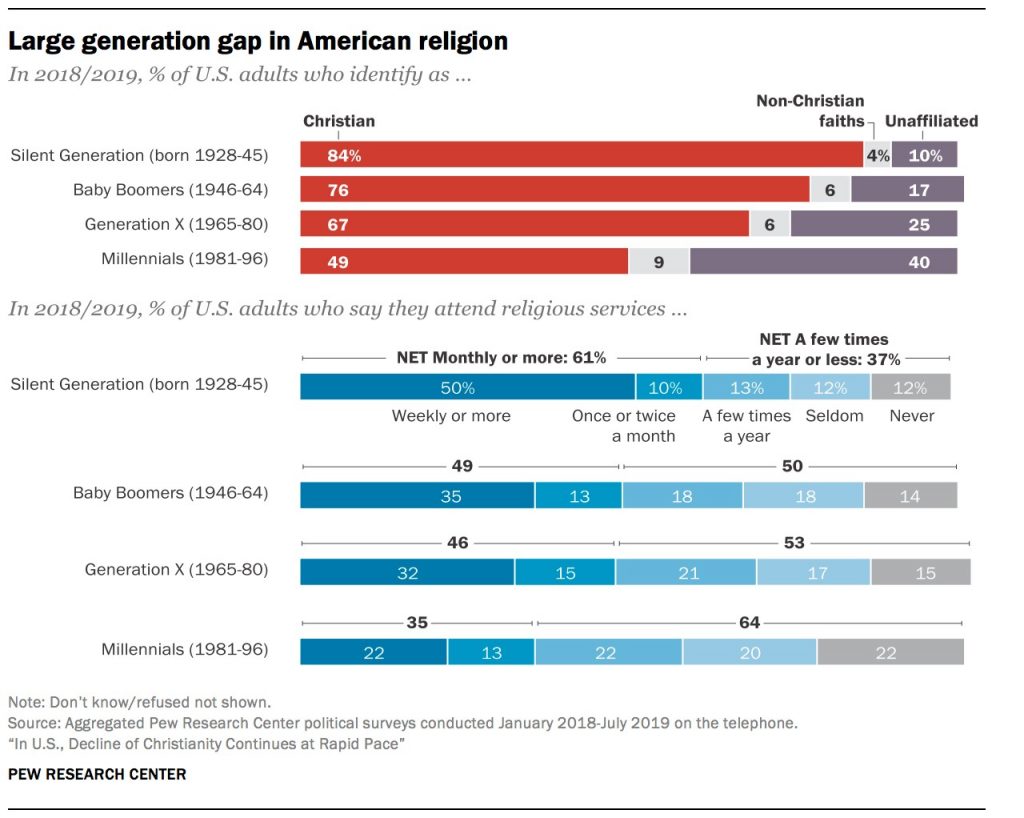
¤
DATA IS BEAUTIFUL Click-through to see this fascinating dynamic timeline of the most popular music artists between 1969 and 2019 based on yearly certified record sales. And be prepared for more Neil Diamond that you might expect.

¤
NEW YORK MAGAZINE “In the 2010s, White America Was Finally Shown Itself. Ta-Nehisi Coates on ‘Obama’s decade,’ reparations, and Kaepernick.” Coates has been busy writing Black Panther graphic novels and old-fashioned word novels for awhile now, and hasn’t been commenting on current events. He does here, and is always worth reading.
¤
NEW YORK TIMES BOOK REVIEW “Phoebe Waller-Bridge Loves Antiheroines. Of Course.”An expectedly delightful interview with the creator of Fleabag about her favorite books, ideal reading experience (wine, armchair, raining), and the most interesting thing she learned from a book recently (since this is a family email newsletter, you’ll have to click through to find out).
¤
CORRECTION OF THE WEEK:
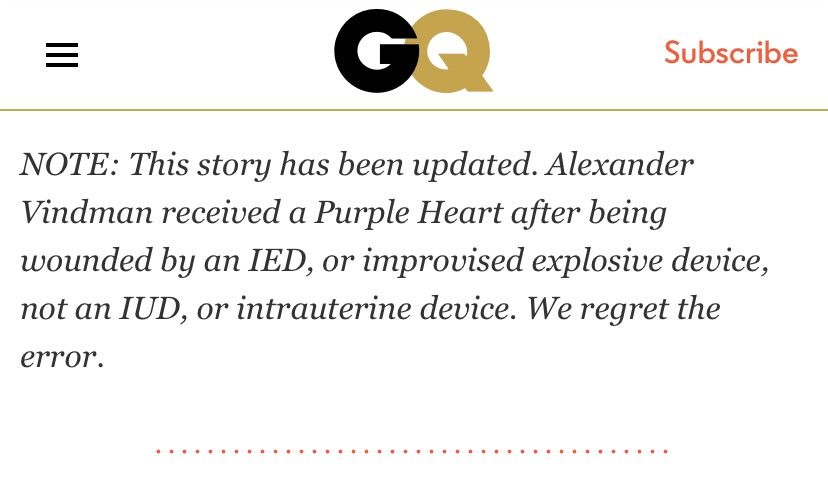
¤
TWEET OF THE WEEK:
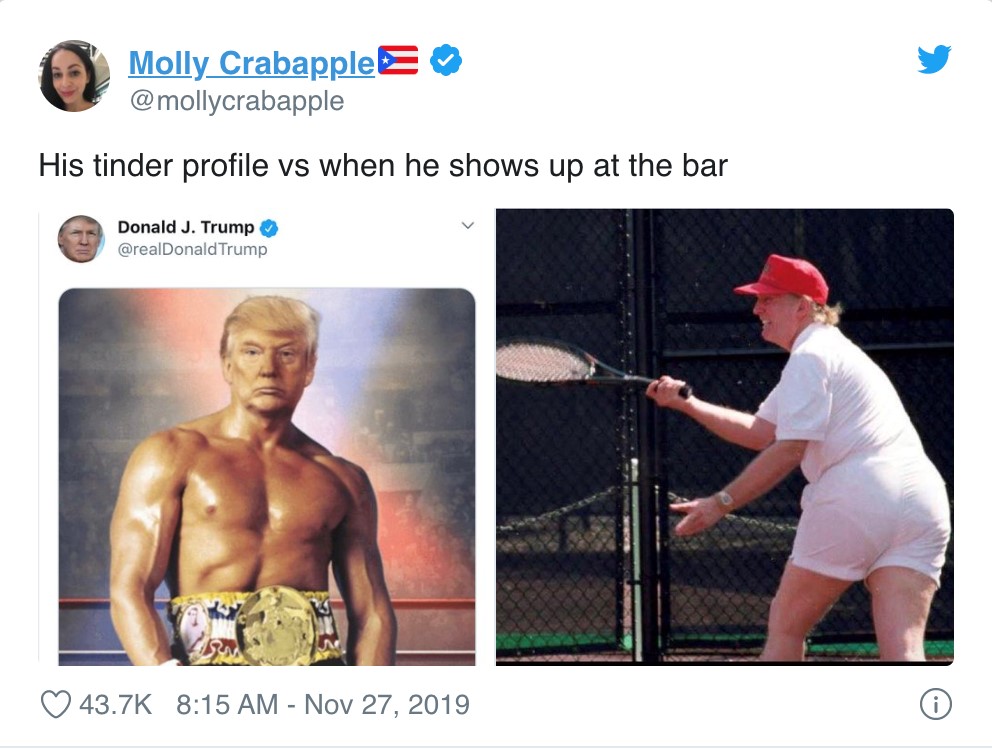
Follow Steve Lichtman during the week on Twitter @stevel3000.


